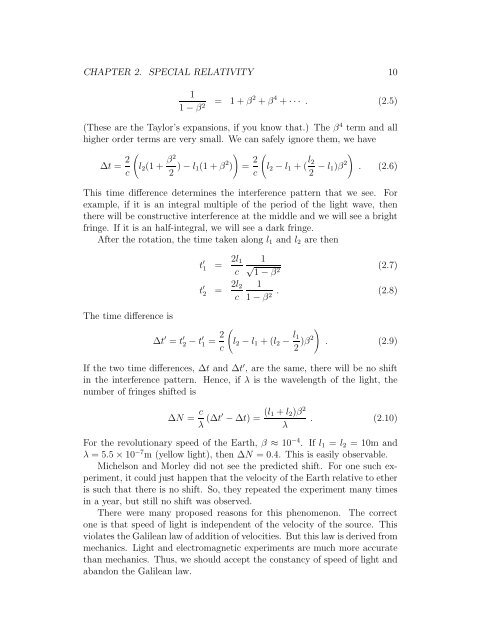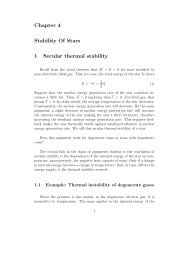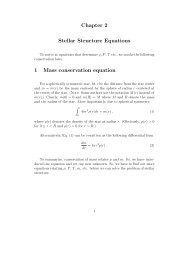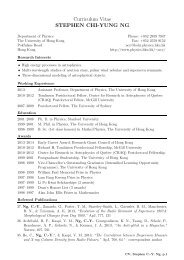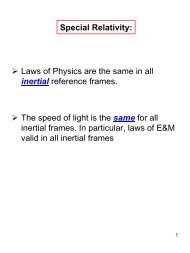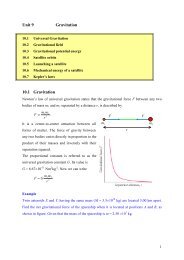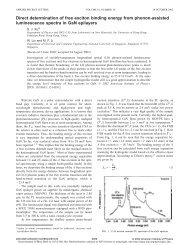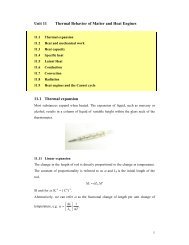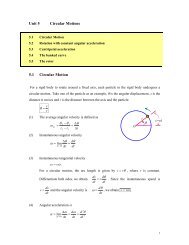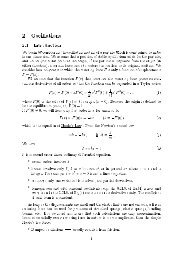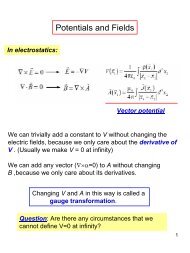here - Department of Physics, HKU
here - Department of Physics, HKU
here - Department of Physics, HKU
You also want an ePaper? Increase the reach of your titles
YUMPU automatically turns print PDFs into web optimized ePapers that Google loves.
CHAPTER 2. SPECIAL RELATIVITY 10<br />
1<br />
1 − β 2 = 1 + β 2 + β 4 + · · · . (2.5)<br />
(These are the Taylor’s expansions, if you know that.) The β 4 term and all<br />
higher order terms are very small. We can safely ignore them, we have<br />
∆t = 2 c<br />
(<br />
)<br />
l 2 (1 + β2<br />
2 ) − l 1(1 + β 2 )<br />
= 2 c<br />
(<br />
l 2 − l 1 + ( l 2<br />
2 − l 1)β 2 )<br />
. (2.6)<br />
This time difference determines the interference pattern that we see. For<br />
example, if it is an integral multiple <strong>of</strong> the period <strong>of</strong> the light wave, then<br />
t<strong>here</strong> will be constructive interference at the middle and we will see a bright<br />
fringe. If it is an half-integral, we will see a dark fringe.<br />
After the rotation, the time taken along l 1 and l 2 are then<br />
The time difference is<br />
t ′ 1 = 2l 1<br />
c<br />
t ′ 2 = 2l 2<br />
c<br />
∆t ′ = t ′ 2 − t′ 1 = 2 c<br />
(<br />
1<br />
√ 1 − β<br />
2<br />
(2.7)<br />
1<br />
1 − β 2 . (2.8)<br />
l 2 − l 1 + (l 2 − l 1<br />
2 )β2 )<br />
. (2.9)<br />
If the two time differences, ∆t and ∆t ′ , are the same, t<strong>here</strong> will be no shift<br />
in the interference pattern. Hence, if λ is the wavelength <strong>of</strong> the light, the<br />
number <strong>of</strong> fringes shifted is<br />
∆N = c λ (∆t′ − ∆t) = (l 1 + l 2 )β 2<br />
λ<br />
. (2.10)<br />
For the revolutionary speed <strong>of</strong> the Earth, β ≈ 10 −4 . If l 1 = l 2 = 10m and<br />
λ = 5.5 × 10 −7 m (yellow light), then ∆N = 0.4. This is easily observable.<br />
Michelson and Morley did not see the predicted shift. For one such experiment,<br />
it could just happen that the velocity <strong>of</strong> the Earth relative to ether<br />
is such that t<strong>here</strong> is no shift. So, they repeated the experiment many times<br />
in a year, but still no shift was observed.<br />
T<strong>here</strong> were many proposed reasons for this phenomenon. The correct<br />
one is that speed <strong>of</strong> light is independent <strong>of</strong> the velocity <strong>of</strong> the source. This<br />
violates the Galilean law <strong>of</strong> addition <strong>of</strong> velocities. But this law is derived from<br />
mechanics. Light and electromagnetic experiments are much more accurate<br />
than mechanics. Thus, we should accept the constancy <strong>of</strong> speed <strong>of</strong> light and<br />
abandon the Galilean law.


